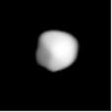astro.wikisort.org - Asteroid
Athamantis (minor planet designation: 230 Athamantis) is a fairly large main-belt asteroid that was discovered by the German-Austrian astronomer K. de Ball on September 3, 1882, in Bothkamp. It was his only asteroid discovery. The asteroid was named after Athamantis, daughter of Athamas the mythical Greek king of Orchomenus.
 | |
| Discovery | |
|---|---|
| Discovered by | K. de Ball |
| Discovery date | 3 September 1882 |
| Designations | |
MPC designation | (230) Athamantis |
| Pronunciation | /æθəˈmæntɪs/ |
Named after | Helle |
Alternative designations | 1949 WG |
Minor planet category | Main belt |
| Orbital characteristics[1] | |
| Epoch 31 July 2016 (JD 2457600.5) | |
| Uncertainty parameter 0 | |
| Observation arc | 133.58 yr (48791 d) |
| Aphelion | 2.52818 AU (378.210 Gm) |
| Perihelion | 2.23641 AU (334.562 Gm) |
Semi-major axis | 2.38229 AU (356.386 Gm) |
| Eccentricity | 0.06124 |
Orbital period (sidereal) | 3.68 yr (1343.0 d) |
Average orbital speed | 19.3 km/s |
Mean anomaly | 116.2° |
Mean motion | 0° 16m 4.969s / day |
| Inclination | 9.443° |
Longitude of ascending node | 239.9° |
Argument of perihelion | 139.1° |
| Physical characteristics | |
| Dimensions | c/a = 0.76±0.07[2] |
Mean diameter | 118±2 km[2] 108.99±2.0 km[1] 110.17 ± 4.57 km[3] |
| Mass | (2.3±1.1)×1018 kg[2] (1.89±0.19)×1018 kg[3] |
Mean density | 2.7±1.3 g/cm3[2] 2.69±0.43 g/cm3[3] |
Synodic rotation period | 24.0055 h (1.00023 d)[1] 23.99 h[4] |
Geometric albedo | 0.146 (calculated)[2] 0.1708±0.006 |
Spectral type | S |
Absolute magnitude (H) | 7.35 |
Photometric observations of this asteroid gave a light curve with a period of 23.99 hours and a brightness variation of more than 0.20 in magnitude.[4] It has the spectrum of an S-type asteroid. During 1991, the asteroid was observed occulting a star. The resulting chords provided a cross-section diameter estimate of 101.8 km.[5]

References
- "230 Athamantis". JPL Small-Body Database. NASA/Jet Propulsion Laboratory. Retrieved 12 May 2016.
- P. Vernazza et al. (2021) VLT/SPHERE imaging survey of the largest main-belt asteroids: Final results and synthesis. Astronomy & Astrophysics 54, A56
- Carry, B. (December 2012), "Density of asteroids", Planetary and Space Science, vol. 73, pp. 98–118, arXiv:1203.4336, Bibcode:2012P&SS...73...98C, doi:10.1016/j.pss.2012.03.009. See Table 1.
- Zeigler, K. W.; Florence, W. B. (June 1985), "Photoelectric photometry of asteroids 9 Metis, 18 Melpomene, 60 Echo, 116 Sirona, 230 Athamantis, 694 Ekard, and 1984 KD", Icarus, vol. 62, no. 3, pp. 512–517, Bibcode:1985Icar...62..512Z, doi:10.1016/0019-1035(85)90191-5.
- Shevchenko, Vasilij G.; Tedesco, Edward F. (September 2006), "Asteroid albedos deduced from stellar occultations", Icarus, 184 (1): 211–220, Bibcode:2006Icar..184..211S, doi:10.1016/j.icarus.2006.04.006.
External links
- The Asteroid Orbital Elements Database
- Minor Planet Discovery Circumstances
- Asteroid Lightcurve Data File
- 230 Athamantis at AstDyS-2, Asteroids—Dynamic Site
- 230 Athamantis at the JPL Small-Body Database
На других языках
[de] (230) Athamantis
(230) Athamantis ist ein Asteroid des Asteroidengürtels, der am 3. September 1882 von Leo Anton Carl de Ball an der Sternwarte Bothkamp bei Kiel entdeckt wurde. De Ball hatte in dieser Nacht eigentlich den Asteroiden (12) Victoria beobachten wollen.- [en] 230 Athamantis
[es] (230) Athamantis
(230) Athamantis es un asteroide que forma parte del cinturón de asteroides y fue descubierto el 3 de septiembre de 1882 por Leo Anton Karl de Ball desde el observatorio de Bothkamp, Alemania. Está nombrado por Atamantis, un personaje de la mitología griega.[2][ru] (230) Афаманта
(230) Афаманта (др.-греч. Αθαμαντίς) — довольно крупный астероид главного пояса, принадлежащий к светлым астероидам класса S. Он был обнаружен 3 сентября 1882 года[1] германо-австрийским астрономом Л. А. К. де Баллом (англ.) (рус. в Боткампской обсерватории и назван в честь Геллы (Афаманты), дочери орхоменского царя Афаманта и Нефелы в древнегреческой мифологии[2].Текст в блоке "Читать" взят с сайта "Википедия" и доступен по лицензии Creative Commons Attribution-ShareAlike; в отдельных случаях могут действовать дополнительные условия.
Другой контент может иметь иную лицензию. Перед использованием материалов сайта WikiSort.org внимательно изучите правила лицензирования конкретных элементов наполнения сайта.
Другой контент может иметь иную лицензию. Перед использованием материалов сайта WikiSort.org внимательно изучите правила лицензирования конкретных элементов наполнения сайта.
2019-2025
WikiSort.org - проект по пересортировке и дополнению контента Википедии
WikiSort.org - проект по пересортировке и дополнению контента Википедии